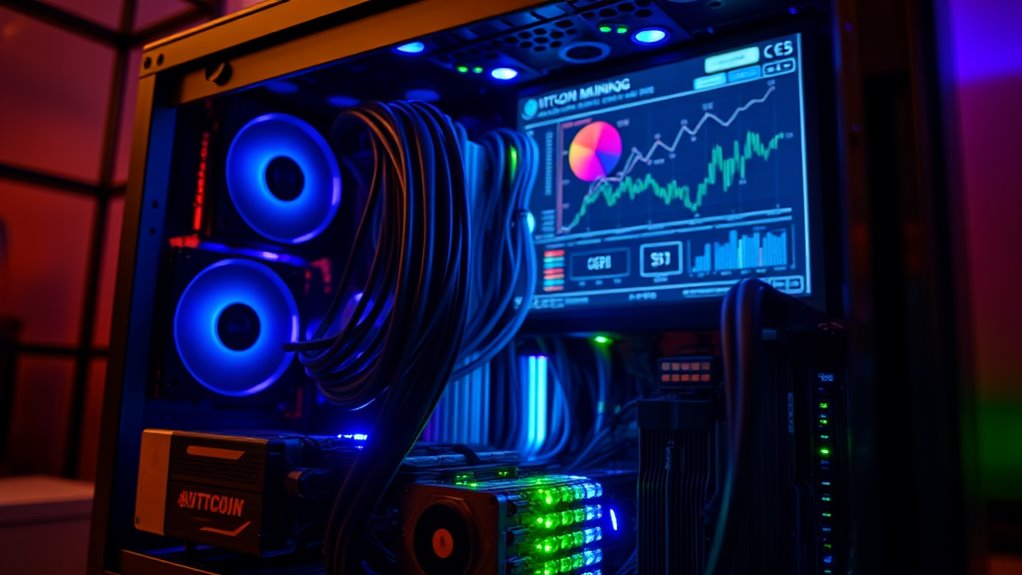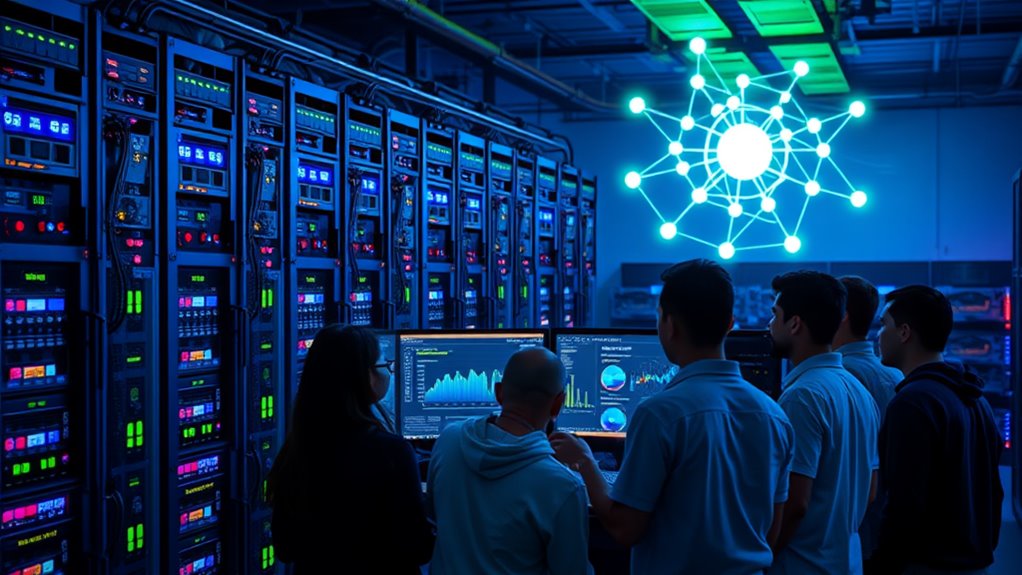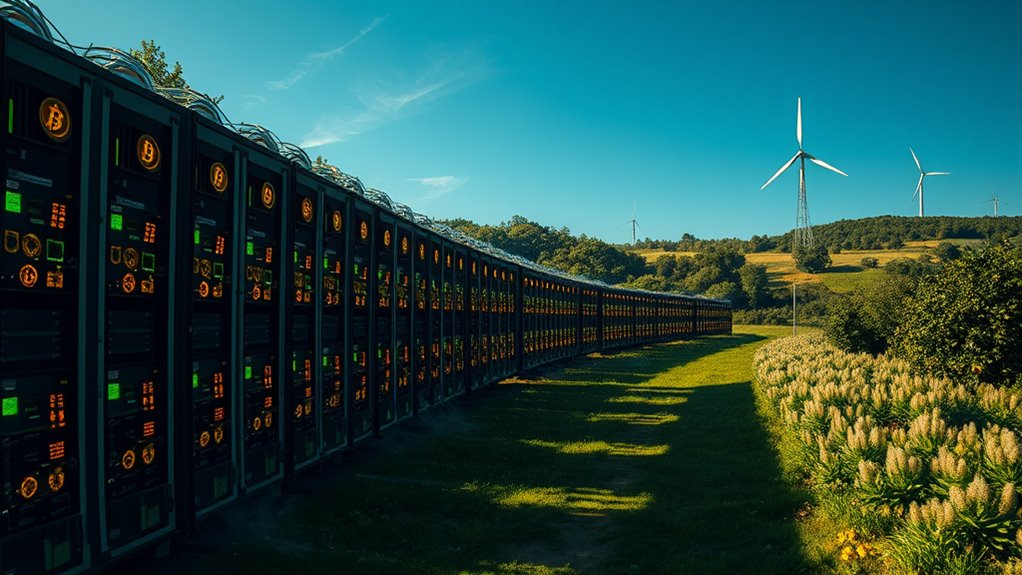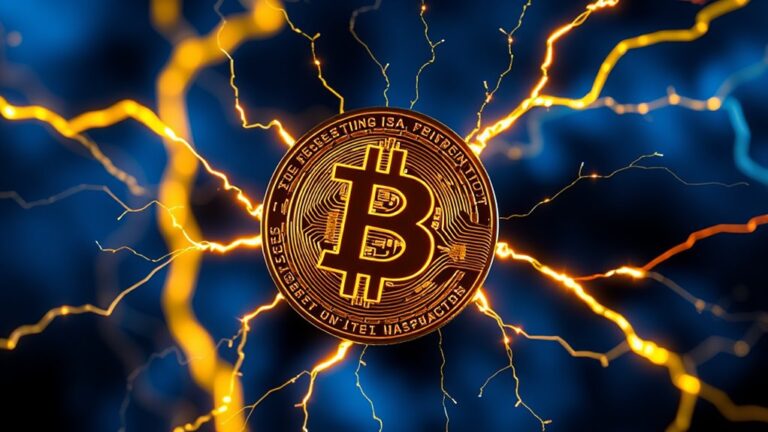
How Bitcoin Mining Works: Explained for Beginners
Bitcoin mining is a process that guarantees the validity and recording of transactions within a decentralized network. Miners use powerful computers to solve complex mathematical puzzles, creating new blocks linked to previous ones. They earn rewards in the form of newly minted Bitcoins and transaction fees. The mining process is supported by the blockchain, which serves as a public ledger, maintaining transaction integrity. Understanding these elements reveals more intricate details about how Bitcoin mining operates effectively.
Table of Contents
Key Takeaways
- Bitcoin mining involves validating and recording transactions on a decentralized network, ensuring security and reliability through Proof of Work.
- Miners solve complex mathematical problems to create new blocks, receiving Bitcoin rewards and transaction fees for their efforts.
- Each block contains a Merkle root and links to the blockchain, maintaining transaction integrity and preventing double-spending.
- Mining rewards decrease over time due to halving events, making transaction fees increasingly important for miners’ profitability.
- Mining pools allow miners to collaborate, improving chances of earning consistent rewards while sharing resources and costs.
Understanding Bitcoin Mining

Bitcoin mining, although often misunderstood, serves as a fundamental process that enables the Bitcoin network to function effectively. This process involves validating and recording transactions across a decentralized network of computers worldwide.
Miners compete to solve complex mathematical problems, ensuring the security and integrity of the Bitcoin ecosystem. Their primary objective is to create new blocks, which are essential for maintaining the network’s immutability. Successful miners are rewarded with newly minted Bitcoins and transaction fees, providing an incentive for their efforts.
In this context, the Proof of Work mechanism plays a crucial role in securing the network against attacks. Specialized hardware, like ASICs and GPUs, is used to enhance mining efficiency, although this equipment can be costly. Moreover, the energy consumption associated with mining presents ongoing challenges that miners must address to remain viable in the competitive landscape.
The Step-by-Step Mining Process

The step-by-step process of mining is essential for maintaining the integrity and functionality of the Bitcoin network.
Initially, miners collect pending transactions from the mempool and organize them into blocks, prioritizing those with higher fees. Each block references the previous one, forming a secure chain.
To validate a block, miners must solve a complex Proof-of-Work puzzle, which involves adjusting a variable called the nonce to find a specific hash.
Once a miner successfully solves this puzzle, they broadcast the block to the network for verification. If approved, the block is added to the blockchain.
The miner receives a reward in the form of newly minted Bitcoins and transaction fees, ensuring continued participation in the decentralized network. Mining difficulty can significantly impact a miner’s profitability by determining how challenging it is to solve the Proof-of-Work puzzle.
The Role of Blockchain in Mining

In the domain of Bitcoin mining, the blockchain plays an essential role in the transaction validation process, ensuring that each transaction is accurately recorded and secure.
The creation of new blocks involves miners verifying these transactions and linking them to a growing chain, which enhances the overall security of the network. This process is made possible through a peer-to-peer network, allowing miners to communicate directly and collaborate effectively.
Transaction Validation Process
Validating transactions is a fundamental step in the process of maintaining the integrity of the blockchain. Bitcoin nodes play a significant role in this process, as they verify transactions before miners can add them to the blockchain.
Each transaction undergoes checks for legitimate signatures and sufficient funds to prevent issues like double-spending. By storing a complete copy of the blockchain, nodes guarantee that only valid transactions are processed. They also relay information across the network, enhancing communication.
This decentralized approach helps maintain security and resilience, as no single entity controls transactions. Overall, transaction validation is essential for upholding trust in the Bitcoin network and guaranteeing that all participants can transact safely. Additionally, understanding the decentralized nature of mining is crucial for grasping how Bitcoin operates as a secure currency.
Block Creation Mechanism
While the process of creating new blocks is vital for the functioning of the Bitcoin network, understanding the block creation mechanism sheds light on how transactions are securely recorded.
This mechanism relies on several key components:
- Decentralized Ledger: The blockchain acts as a public ledger, guaranteeing transparency and security.
- Block Formation: Miners collect pending transactions from the mempool to create new blocks.
- Hashing Process: Each block contains a Merkle root, verifying the integrity of its transactions.
Once a miner successfully creates a block, it is broadcast to the network for verification.
This guarantees that only legitimate transactions are added, maintaining the integrity of the blockchain.
Consequently, the block creation mechanism is vital for Bitcoin’s functionality and security.
Network Security Enhancement
The security of the Bitcoin network is greatly enhanced by its underlying blockchain technology, which provides a robust framework for transaction verification and integrity. This decentralized architecture prevents any single entity from dominating the network, thereby reducing vulnerability to attacks. The Proof of Work consensus mechanism guarantees that validating transactions requires significant computational power, making fraud expensive. Additionally, once transactions are confirmed, they become immutable, safeguarding against alterations. Moreover, the energy consumption associated with carbon footprints in mining activities has sparked ongoing debates about the environmental impact of cryptocurrency.
| Feature | Description | Impact on Security |
|---|---|---|
| Decentralization | Control is distributed across many nodes | Harder for one entity to corrupt |
| Proof of Work (PoW) | Requires computational effort to validate transactions | Deters fraudulent actions |
| Global Distribution | Nodes are spread around the world | Increases resilience against attacks |
These elements collectively fortify the network’s security.
Mining Rewards and Incentives

Mining rewards play a vital role in the Bitcoin network, serving as the primary incentive for miners to validate transactions and maintain security.
These rewards consist of block subsidies, which are newly minted Bitcoins, and transaction fees collected from users.
Understanding the dynamics of these rewards is essential, especially as changes in block rewards and market conditions shape the future of Bitcoin mining.
Block Rewards Explained
Block rewards play an essential role in the operation of blockchain networks, particularly in Bitcoin. These rewards act as an incentive for miners, ensuring the security and validation of transactions. The block reward comprises newly minted cryptocurrency and transaction fees, reflecting its dual function in the ecosystem.
Key aspects of block rewards include:
- Initial and Current Reward: The first Bitcoin block reward was 50 BTC, now reduced to 3.125 BTC.
- Halving Events: Block rewards halve approximately every four years, controlling supply and preventing inflation.
- Network Security: Rewards motivate miners to secure the network and maintain its integrity through computational efforts. Additionally, the evolution of Bitcoin has significantly influenced the dynamics of mining rewards over the years.
Transaction Fees Role
Transaction fees serve as a vital component in the Bitcoin mining ecosystem, acting as a significant incentive for miners to validate and add transactions to the blockchain.
These fees are calculated based on the size of a transaction, with larger transactions typically incurring higher fees. During times of network congestion, fees can increase, encouraging miners to prioritize transactions that offer higher compensation.
As block rewards diminish over time, transaction fees will become increasingly important for sustaining miner incentives and ensuring network security. Additionally, understanding how Bitcoin fees are calculated can help users make more cost-effective decisions when sending transactions.
In addition, the fluctuating nature of these fees creates a dynamic market where miners select high-fee transactions to optimize their revenue, ultimately shaping how efficiently block space is utilized within the network.
Types of Mining Hardware

In the domain of cryptocurrency, various types of mining hardware play an essential role in the process of validating transactions and securing the network.
Each hardware type has unique characteristics suited for different mining requirements:
- CPUs: Initially popular for their accessibility, they are now ineffective for Bitcoin mining due to increased difficulty.
- GPUs: Offering higher computational power than CPUs, they are adaptable for various cryptocurrencies but are more energy-intensive.
- ASICs: Application-Specific Integrated Circuits are the most efficient for Bitcoin mining, providing high hash rates and energy efficiency, making them the preferred choice for large operations.
Understanding these hardware types helps potential miners choose the appropriate equipment for their specific goals in the cryptocurrency landscape.
The Impact of Mining Difficulty

How does mining difficulty affect the broader Bitcoin ecosystem?
Mining difficulty is essential for maintaining the integrity and security of the Bitcoin network. It adjusts approximately every two weeks to guarantee that new blocks are created at a consistent rate of about 10 minutes.
Mining difficulty is crucial for the Bitcoin network’s security, adjusting biweekly to ensure a steady block creation rate of roughly 10 minutes.
When the total computational power, or hash rate, of the network increases, difficulty rises accordingly. This adjustment can influence miners’ operational costs and profitability, as higher difficulty requires more advanced equipment and energy consumption.
Additionally, these adjustments promote network stability, preventing fluctuations in transaction confirmation times.
Ultimately, mining difficulty plays a significant role in controlling Bitcoin’s supply and safeguards the network against potential attacks, contributing to its overall resilience.
Joining Mining Pools for Better Returns

Joining mining pools represents a strategic approach for individuals seeking more reliable returns in the Bitcoin mining landscape. By pooling resources, miners can benefit from several advantages that enhance their mining experience:
- Consistent Income: Earnings become more predictable compared to solo efforts.
- Lower Barriers to Entry: Smaller miners can participate without needing vast resources.
- Shared Rewards: Participants receive portions of block rewards and transaction fees.
Mining pools work by combining computational power to solve cryptographic puzzles, increasing the chances of successfully finding blocks. Additionally, Layer 2 solutions can help alleviate network congestion, allowing for smoother transaction processing within mining pools.
Pools also manage the coordination of miners, ensuring efficient work distribution. With various payout systems and fees, choosing the right pool can optimize profitability, making it a favored option among both novice and experienced miners.
Environmental Considerations in Bitcoin Mining

Bitcoin mining, while providing opportunities for profit through pooled resources, also raises significant environmental concerns that warrant attention.
The process is highly energy-intensive, consuming around 173 TWh of electricity annually, comparable to medium-sized nations. A large portion of this energy still comes from fossil fuels, leading to substantial carbon emissions estimated at 86 megatons in 2020-2021.
Additionally, mining operations contribute to air pollution, particularly fine particulate emissions, affecting communities far from the sites. The land and water usage associated with mining is also considerable, raising concerns in water-scarce regions like Kazakhstan.
Shifting to renewable energy sources could mitigate these impacts, promoting sustainable practices and enhancing the profitability of green energy projects within the mining sector.
Frequently Asked Questions
Can Anyone Start Mining Bitcoin From Home?
Anyone can technically start mining Bitcoin from home, but challenges such as high initial costs, intense competition, significant energy consumption, and the need for efficient cooling systems can hinder profitability and sustainability for individual miners.
What Are the Legal Requirements for Bitcoin Mining?
Legal requirements for bitcoin mining vary globally, focusing on local regulations, taxation, and environmental guidelines. Miners must navigate these frameworks, ensuring compliance while considering energy consumption and potential restrictions imposed by their respective jurisdictions.
How Does Bitcoin Mining Affect Transaction Speeds?
Bitcoin mining greatly influences transaction speeds by determining block processing times and transaction prioritization. Factors like miner participation, network congestion, and fee strategies shape overall efficiency, affecting how quickly transactions are confirmed within the network.
What Happens to Miners After Bitcoin Supply Reaches 21 Million?
Once Bitcoin’s supply reaches 21 million, miners will no longer receive block rewards. They will depend on transaction fees for income, potentially leading to higher fees and an evolution of their roles within the network.
Is Bitcoin Mining Profitable in Areas With Low Electricity Costs?
Despite concerns over market volatility, Bitcoin mining remains profitable in areas with low electricity costs. Efficient hardware and favorable energy sources enhance margins, making such locations attractive for miners seeking sustainable operations and competitive advantages.
Conclusion
To sum up, Bitcoin mining is a complex process that serves as the backbone of the cryptocurrency network. Much like a digital gold rush, miners compete to solve intricate puzzles, validating transactions and securing the blockchain. As the landscape evolves, miners face challenges such as increased difficulty and environmental concerns. Understanding these facets is essential for anyone interested in the future of Bitcoin, as they reflect the intricate balance between technology, economics, and sustainability in this digital era.




